| Share |  |
 | |||
Healthful Cooking Oils - Part Two
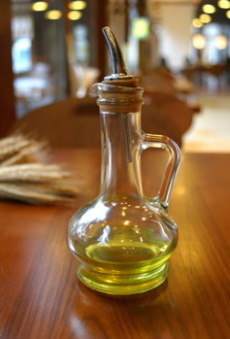 In last month's article we focused on how oils are processed and the effect heat has on oil, particularly when the temperature is beyond its smoke point. Oils containing a high percentage of the more stable saturated fats such as coconut oil were recommended as a healthier alternative for use in cooking than polyunsaturated oils such as refined corn, soy and safflower which not only are less stable but contribute to the overuse of omega-6 oils in the typical American's diet.
In last month's article we focused on how oils are processed and the effect heat has on oil, particularly when the temperature is beyond its smoke point. Oils containing a high percentage of the more stable saturated fats such as coconut oil were recommended as a healthier alternative for use in cooking than polyunsaturated oils such as refined corn, soy and safflower which not only are less stable but contribute to the overuse of omega-6 oils in the typical American's diet.
Monounsaturated oils are also a healthier alternative to polyunsaturated oils as their chemical structure affords greater heat stability as well as protection from oxidation and free radical damage. These oils are high in oleic acid, an omega-9 fatty acid that is the source of their many health-promoting benefits.
Olive oil, the most prominent of the monosaturated oils, has been used for thousands of years and is a key part of the heart healthy Mediterranean diet. It is comprised of approximately 75% oleic acid and only 10% is comprised of omega-6 polyunsaturated fatty acids.
Because it is made from the pressing of the whole olive fruit rather than the seeds like most oils, less pressure and lower temperatures are required during processing which means that more nutrients are preserved. Olive oil is particularly rich in Vitamin E and polyphenols, powerful plant antioxidants that neutralize free radical damage in cells. It helps to lower cholesterol and also has anti-inflammatory and digestive properties. Populations that regularly consume olive oil have lower rates of heart disease and cancer.
There are different types and qualities of olive oil, 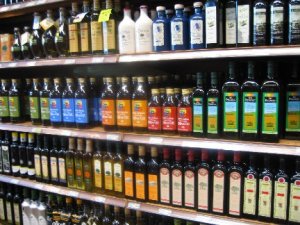 determined primarily by the production method, acidity content and flavor. A higher quality olive oil will be cold pressed with less than 1% acidity - the less acidity, the greater the amount of antioxidants and nutrients remain. The particular taste of an olive oil can be impacted by a number of factors such as the type of olive used and degree of its ripeness, the type of soil and environmental conditions in which olives are grown, the type of harvesting and pressing techniques used and even the type of packaging and storage methods used. Depending on the degree of refining, various smoke points exist for each oil that dictate how that type is best used.
determined primarily by the production method, acidity content and flavor. A higher quality olive oil will be cold pressed with less than 1% acidity - the less acidity, the greater the amount of antioxidants and nutrients remain. The particular taste of an olive oil can be impacted by a number of factors such as the type of olive used and degree of its ripeness, the type of soil and environmental conditions in which olives are grown, the type of harvesting and pressing techniques used and even the type of packaging and storage methods used. Depending on the degree of refining, various smoke points exist for each oil that dictate how that type is best used.
Extra Virgin Olive Oil
Extra virgin olive oil is produced mechanically from the first pressing of the olives by crushing them between stone or steel rollers. This process better preserves the integrity of the fatty acids and nutritive properties of the oil, which helps fat to metabolize in the body more efficiently. Extra virgin olive oil is unrefined and expeller pressed, using no heat or solvents. It has more of a full-bodied flavor and aroma and is the least acidic of the various types, containing no more than 0.8% acidity. Due to the fact that it is the most nutrient dense and least refined, it has a lower smoke point and is more susceptible to oxidative damage than any olive oil. The smoke point can range from 200 degrees-350 degrees depending on differences in the degrees of processing. Oil of this quality and nutritive value is best used for salad dressings or vinaigrettes, drizzled over bread or sandwiches or used as butter in vegetable dishes or potatoes after they have been cooked.
Virgin Olive Oil
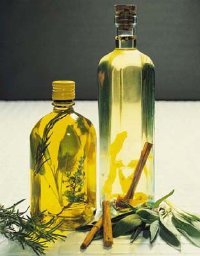 Virgin olive oil is a lower-grade "extra virgin" but it also comes from the first pressing of the olives with no heat or chemical extraction involved. Its acidity level is 1/1/2% - 2% and it is considered to have above average flavor and aroma. The olives are slightly riper than those used in the production of extra-virgin. The smoke point of virgin olive oil varies as well with processing though it generally will be higher than extra virgin oils.
Virgin olive oil is a lower-grade "extra virgin" but it also comes from the first pressing of the olives with no heat or chemical extraction involved. Its acidity level is 1/1/2% - 2% and it is considered to have above average flavor and aroma. The olives are slightly riper than those used in the production of extra-virgin. The smoke point of virgin olive oil varies as well with processing though it generally will be higher than extra virgin oils.
Refined Olive Oil
Any olive oil that does not specify "virgin" on the label can fall into this category though it may be labeled in any number of ways. It can be called just "Olive Oil" or even "Pure Olive Oil" which really is a misnomer since it is actually a lesser grade oil made by adding a little extra virgin olive oil to refined olive oil. The process used removes the imperfections in flavor and aroma, leaving a somewhat bland taste. The color and taste are then improved by adding extra virgin or virgin oil to it. It is "pure" only in the sense that it has not been mixed with any different types of oil. Pure oil has an acidity level that can range from 1 1/2 up to 3%. Its smoke point is listed in the range of 425 degrees-450 degrees.
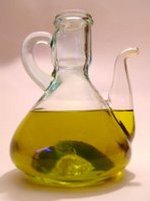
Pomace Olive Oil
Pomace olive oil is produced from the residue paste remaining after the extra virgin and virgin oils have been extracted. It is an inexpensive cooking grade oil produced in the same manner as refined polyunsaturated oil using heat extraction and chemical solvents such as hexane. It has a neutral taste and lighter color with a smoke point of 460 degrees.
"Light & Extra Light" Olive Oil
This category is not really a classification of olive oil grades and no real precedent has been set as to what its content should be since it is not regulated by any certification organizations. It undergoes the most processing of any olive oil and is a mixture of the lowest quality refined olive oils. The name "Light" is a misnomer as well considering it has the same number of calories as regular olive oil. Because it is so processed, its smoke point of 468 degrees is higher than other olive oils.
Cooking Recommendations and Tips
I recommend that you choose organic, expeller-pressed, unrefined oils whenever possible. Organic oils are from plants grown without the use of synthetic pesticides, fungicides, fertilizers, or herbicides. Keep in mind that the higher quality olive oils have the most nutritive value but also the lowest smoke points. Care must be taken not to allow oils be heated at or beyond that smoke point or they could become unsafe. Though I would not recommend using the refined versions of olive oil, if you are going to use olive oil for frying at a higher temperature, it would be safer to use the kinds that are not virgin.
One way to keep oil from becoming too hot while sautéing food is to pour a small amount of water to the skillet and heat it just below boiling. Add the food and cook it a short time before adding the oil and then stir frequently. This method, known as wet-sauté, shortens the time oil is in contact with the hot pan.
Additional Tips for Olive Oil Use
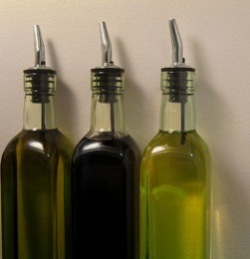 Olive oil may be used as a substitute for butter in recipes as long as the baking temperature does not exceed the smoke point of the oil. Use a slightly smaller amount of olive oil for the amount of butter called for in the recipe. For example: 3/4 teaspoon olive oil for 1 teaspoon of butter or 1/4 cup olive oil for 1/3 cup butter.
Olive oil may be used as a substitute for butter in recipes as long as the baking temperature does not exceed the smoke point of the oil. Use a slightly smaller amount of olive oil for the amount of butter called for in the recipe. For example: 3/4 teaspoon olive oil for 1 teaspoon of butter or 1/4 cup olive oil for 1/3 cup butter.
A "substitute margarine" healthy spread may be made using extra virgin olive oil combined with organic butter in a one to one ratio which may be adjusted according to taste. Allow butter sticks to soften to room temperature, pour in olive oil and whisk until smooth and creamy. Store in a covered container in the refrigerator.
Only buy olive oil that is stored in a dark bottle and still has a long shelf life. Store olive oil in a dark, cool place and be sure bottles are tightly sealed to protect them from air. It can be kept in the refrigerator though it will become cloudy and solidify. However, olive oil returns to its original, liquid state when brought to room temperature again.
Other Monounsaturated Oils
Avocado oil is another healthy monounsaturated oil that is becoming more popular to use in cooking. Its refined version has the highest smoke point of all plant oils at 520 degrees. Though not as high in monounsaturated fats as most monounsaturated oils, peanut oil is a popular choice for stir-fry.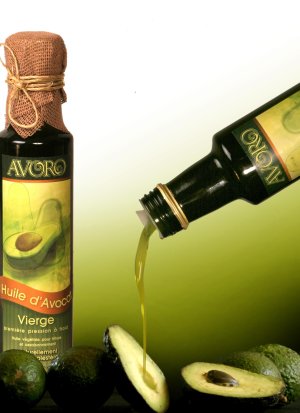 Refined peanut oil can be safety heated up to 450 degress and unrefined peanut oil is safe up to 320 degrees.
Refined peanut oil can be safety heated up to 450 degress and unrefined peanut oil is safe up to 320 degrees.
Canola oil is another monounsaturated oil viewed by many as a heart healthy alternative to standard vegetable oils, though it is not derived from "canola seed" as other seed oils. It is extracted from the seeds of a mustard-like plant generally referred to as "rapeseed" that is mostly grown in western Canada. Unfortunately, about two-thirds of the mono-unsaturated fatty acids in rapeseed oil are erucic acid, a 22-carbon monounsaturated fatty acid known to cause fibrotic lesions of the heart. In the late seventies, a genetically modified version of rapeseed was first developed by Canadian plant breeders who produced an oil lower in erucic acid and higher in oleic acid. The vast majority of Canola oil purchased in grocery stores and used in processed foods comes from these genetically modified crops. Most natural health nutritionists and educators recommend avoiding all genetically modified foods.
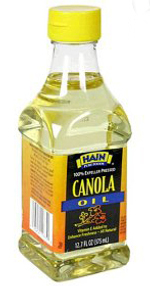 There are varying controversial views surrounding GM Canola oil and the rapeseed plant from which it is derived. Many consider rapeseed a toxic and poisonous weed and it was often used as lubricating oil for small industries or grown near farm crops to repel insects before it was genetically modified. Various reports exist of it being fed to different animals for feed resulting in occurrences of disturbing disorders and symptoms. Regardless of whether or not these reports are true, it is reasonable to conclude that there has not been sufficient time given for studies to be completed on the potential health risks from the widespread use of this genetically modified product. The herbicide resistant strand used today was only developed in 1995.
There are varying controversial views surrounding GM Canola oil and the rapeseed plant from which it is derived. Many consider rapeseed a toxic and poisonous weed and it was often used as lubricating oil for small industries or grown near farm crops to repel insects before it was genetically modified. Various reports exist of it being fed to different animals for feed resulting in occurrences of disturbing disorders and symptoms. Regardless of whether or not these reports are true, it is reasonable to conclude that there has not been sufficient time given for studies to be completed on the potential health risks from the widespread use of this genetically modified product. The herbicide resistant strand used today was only developed in 1995.
Another problem that exists with Canola oil is that it is more than 30% polyunsaturated fatty acids and higher in omega-3 fatty acids than most oils. Because omega-3 easily becomes rancid when subjected to oxygen and high temperatures, it must be deodorized and the steps involved in that process can transform large portions of it into trans fatty acids.
There are companies that claim to produce canola that is not produced from genetically modified rapeseed crops. Their organic expeller pressed Canola oil would be the safest to use. As with all unrefined oils, the smoke point is much lower than the refined Canola oil available in grocery stores that can go as high as 400 degrees.
Although sunflower and safflower oils are usually higher in polyunsaturated fatty acids, there are "high oleic" versions that are very high in monounsaturated fatty acids and low in polyunsaturated fatty acids. High oleic sunflower oil has 84% monounsaturated fats and high oleic safflower oil has 75% monounsaturated fats, making them far more stable than traditional varieties. The refined versions have very high smoke points but they do make unrefined cold-pressed versions of these oils, albeit difficult to obtain. The smoke point for unrefined high oleic sunflower is 320 degrees and the smoke point for high oleic unrefined safflower oil is 325 degrees.
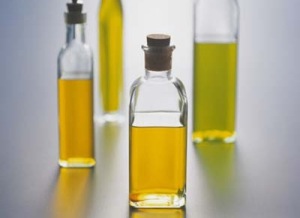 Conclusion
Conclusion
It is best to carefully read labels on bottles of oil to learn information concerning smoke point, processing methods and purity for a particular manufacturer's oil. Use oils sparingly even when they are heart healthy monounsaturated oils as just two tablespoons adds around 120 calories. Choosing the right oils for your food preparation and cooking and following safe guidelines in their use will benefit and protect the health of you and your family.
Copyright © 2008-2015 Lucinda Bedogne, CNHP, CNC
Post Your Comment...
|
|
||||||||||||



